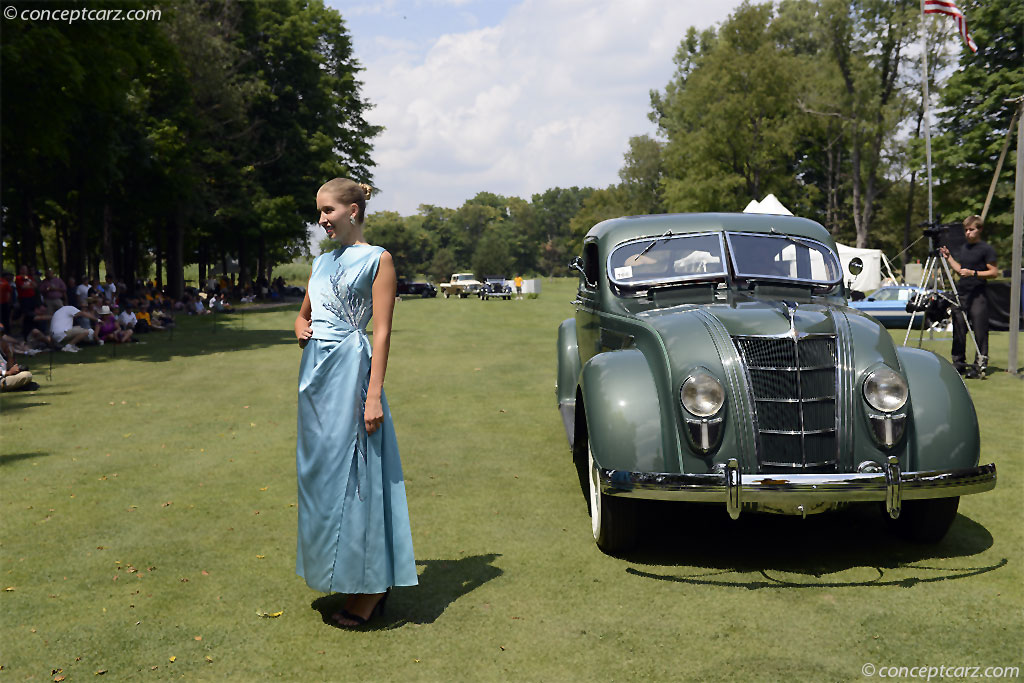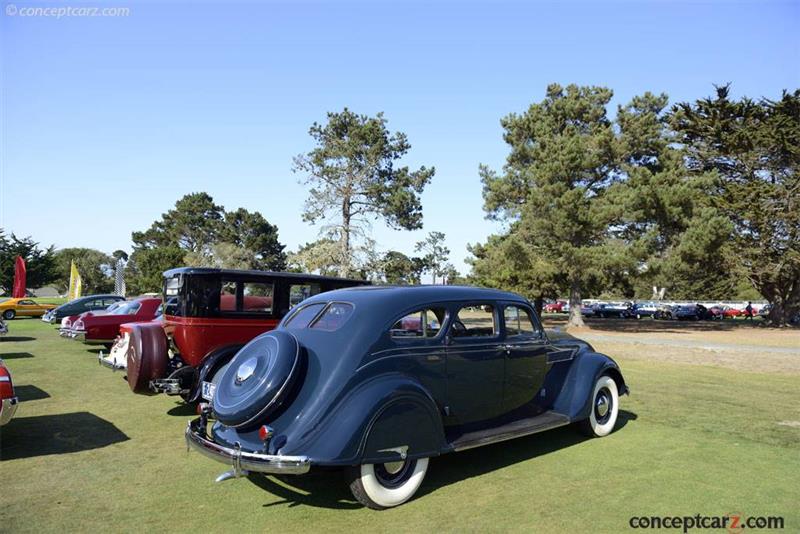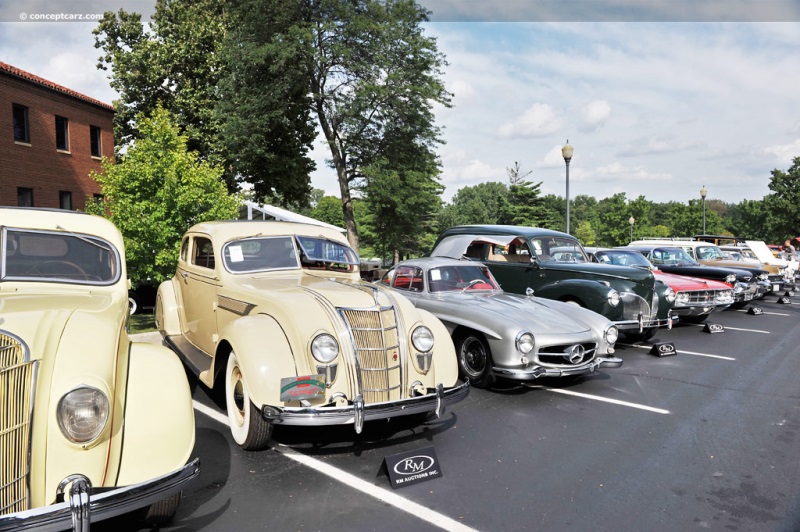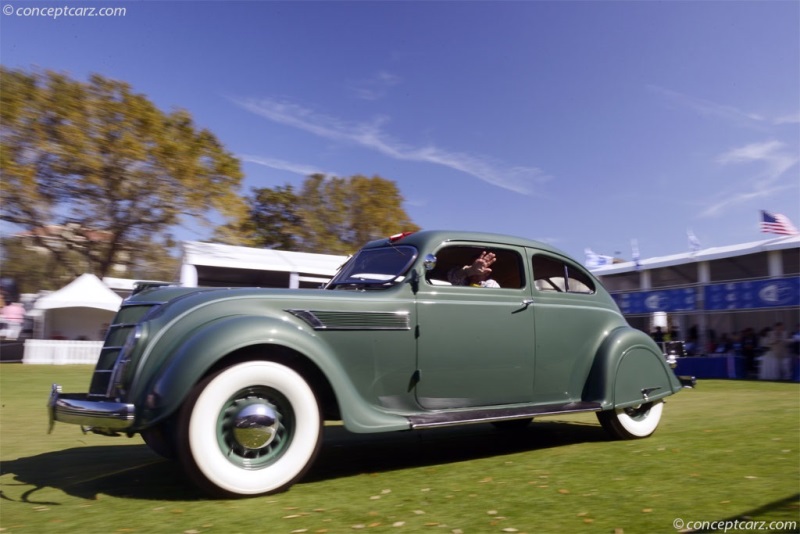Walter P. Chrysler was working for Studebaker in 1920 and when he left for Willys when he took over operations of that company, three engineers came with him. They followed him when the Chrysler Corporation was launched and helped build a strong organization. Carl Breer, Owen Skelton, and Fred Zeder were known as 'Chrysler's Three Musketeers,' and the Airflow was their implementation of 'form follows function' and its streamlined 'Art Deco' inspired shape was perfected in a wind-tunnel. Its semi-unitary truss bridge chassis was based on aircraft principles and its engine was positioned forward, over the front axle, which allowed both seats to be placed within the wheelbase. It was roomy, comfortable, and its styling was among the most revolutionary and influential of the 1930s. Introduced in 1934, the public did not agree with its radical styling and sales were lower than expected. In an effort to stimulate sales, the front end and grille styling were toned down, gaining a more conventional appearance. 
Coupe
Chassis #: C2-3227
View info and history
Auction entries : 1The Airflow pioneered many new construction methods for the industry that is still in use today, including being one of the first to use wind tunnel testing which has become commonplace in modern automotive designs. The 'Vee'd' split windscreen was considered revolutionary for its day, reducing air resistance and complementing the gentle sloping body lines and aerodynamic features. Most automakers of the era used wood structural framing members in their car bodies, while the Airflow utilized a full-steel body. The interior was comfortable and well-appointed, with plush fabrics, tight-fitting doors, decorative chrome, and a well-thought-out arrangement of dashboard gauges. The rear seat was deeper, and the front seat was wider than in other vehicles. They had exposed chromed tubular frames and most featured cloth upholstery that had leather accents and piping, while a few received all-leather upholstery. Its power-to-weight ratio and structural integrity were stronger than other similar models of the day. Chrysler demonstrated the Airflow's structural strength by pushing one off a 110-ft high cliff, then driving the car away. The company proudly declared the Airflow as 'The first rear motorcar.' Improvements for 1935 went beyond aesthetics, including an improved braking system and a larger and more powerful engine. Sales continued to lag behind contemporary offerings from Chrysler, however, its design did find favor with several European car makers with similar design cues incorporated into the Czech-built Tatras and the French-built Peugeot of the late 1930s. It is believed that even Dr. Ferdinand Porsche may have acquired an Airflow in Germany and used its basic design for his early Volkswagen concepts. The 1935 Chrysler model lineup included the Airstream available with either six- or eight-cylinder power and in Deluxe (CZ) configuration which added additional chrome trim, dual trumpet horns, dual bullet-shaped taillights, fender-mounted parking lights, and a winged '8' emblem on the front sides of the hood. The Airflow was strictly an eight-cylinder model for 1935 and was offered as the C-1, Imperial C-2, Imperial Custom C-3, and Custom Imperial CW. The C-1 rested on a 123-inch wheelbase and was powered by a 323.5 cubic-inch L-head eight with 115 hp (standard). The C-2 rested on a 128-inch wheelbase and was powered by an L-head, 323.5 cubic-inch eight-cylinder engine with a cast-iron block, five main bearings, solid valve lifters, a Stromberg 2V carburetor, and delivered 130 horsepower at 3400 RPM. An optional version with higher compression boosted output to 138 bhp. The C-3 rested on a 130-inch wheelbase and was equipped with the same engine as the C-2. The Series CW had a 146.5-inch wheelbase and a 384.8 CID L-head inline-8 with 150 horsepower. The three-speed manual was standard on all models except the Imperial Airflows which had an automatic overdrive. The Imperials also had overdrive on fourth gear. All Chrysler Airflows were closed models with the vast majority being the four-door sedan. The Chrysler C-2 was offered as a two-door coupe or four-door sedan with both body styles listing for $1,475. These were slightly higher than the $1,245 price of the C-1 but less than the $2,245 of the C-3. The CW was the most expensive with prices beginning at $5,000. The combined sales of the C-1 for 1935 were just under 5,000 units. 2,598 examples of the C-2 were sold including 200 of the coupe and 2,398 of the sedan. The combined C-3 was even less at just over 100 units and the combined CW production was 32 units. Introduced at the New York Auto Show in January 1934, the Chrysler Airflow was offered until 1937. The first year featured the curved 'waterfall' grille and is considered the purest expression of the design, devoid of compromises to appease skeptics. It was a bold and radical departure from anything that preceded it, bursting with technical ingenuity, a novel beam and truss design, lightweight construction, superb strength, and a spacious interior. Despite the over 50 engineering first and 72 national speed records, the public never quite warmed to the styling, and the Airflow disappeared after 1937 with only 55,000 produced for both Chrysler and DeSoto car lines over four years.
by Daniel Vaughan | Oct 2021
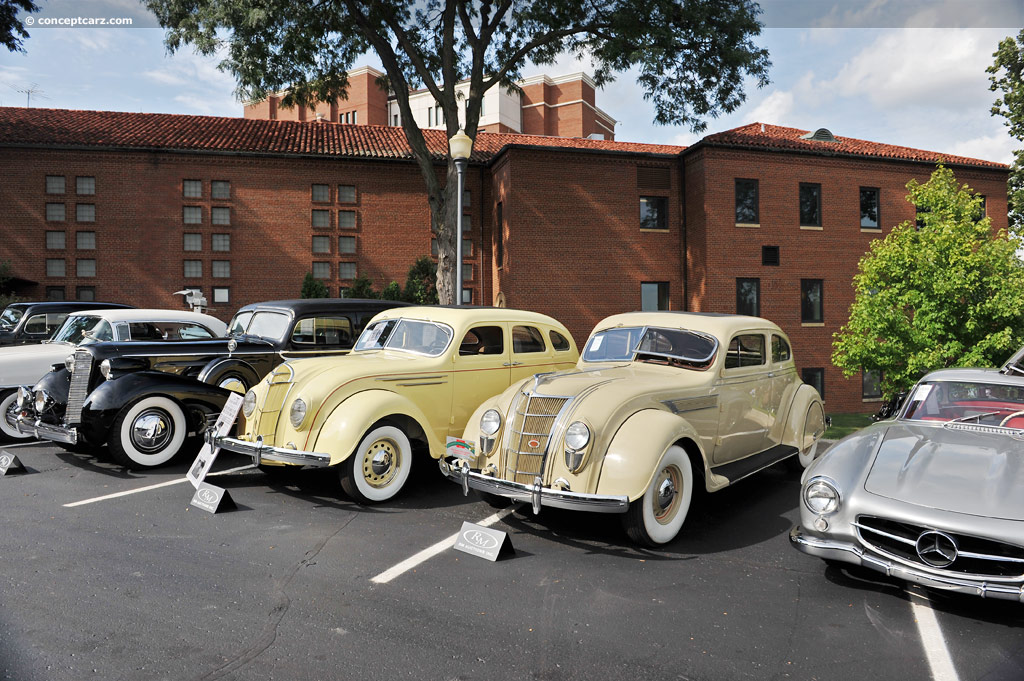
Coupe
Chassis #: C2-3227
View info and history
Auction entries : 1
by Daniel Vaughan | Oct 2021
With the name bearing a royal theme, the Imperial symbolized luxury and comfort for the Chrysler Corporation. Even through the depression, Chrysler kept its theme and produced the Imperial with top-of-the-line interior and exterior parts.
Coupe
Chassis #: C2-3227
View info and history
Auction entries : 1Adding to the line were the ideas of Le Baron - Dietrich and Locke. From this duo of Le Baron & Chrysler came the 1934 Airflow Imperial. Weighing in at over 5,850 pounds, it would be the heaviest production Imperial. The smaller versions would prove to sell better than the larger, more optioned versions. It also featured for the first time, a chassis and body in one piece providing stronger support for drivers and passengers. The Airflow would also break records on the Utah salt flats and set other new closed stock car records. But by 1937, due to sales, only one Airflow model was being built. With a little higher price tag than other Chryslers, the company never sold an extensive amount of the Imperials. But regardless, Walter P. Chrysler still gained a niche in the luxury vehicle market.Kyle McMullen

Coupe
Chassis #: C2-3227
View info and history
Auction entries : 1
Related Reading : Chrysler Airflow History
The Chrysler Airflow was introduced in 1934 as an exercise in aerodynamics, form, and function. Soon, the Airflow would be used by the Chryslers counterpart, the DeSoto Motor Company. The interior was surprisingly roomy and comfortable. The eight-cylinder engine provided around 115 horsepower or more depending on the options selected. It was a design that was far ahead of its time. Unfortunately,....
Continue Reading >>
Continue Reading >>
Related Reading : Chrysler Airflow History
Produced from 1934 until 1937, the Chrysler Airflow was the original full-size American production vehicle that used streamlining as a basis for building a sleeker automobile, one less susceptible to air resistance. Though it ended up being what is considered by some a commercial failure, Chrysler did make an effort at a fundamental change in automotive design with the Chrysler Airflow. Chryslers....
Continue Reading >>
Continue Reading >>
Similar Vehicles
Chrysler Monthly Sales Volume
March 2023
31,899
1935 Chrysler Airflow Imperial Series C-2 Vehicle Profiles
Recent Vehicle Additions
Performance and Specification Comparison
Price Comparison
$745 - $870
$910 - $1,235
Airflow Specification Comparison by Year
Year
Production
Wheelbase
Engine
Prices
128.00 in.
8 cyl., 323.50 CID., 130.00hp
8 cyl., 323.50 CID., 138.00hp
8 cyl., 323.50 CID., 138.00hp
$1,475 - $1,475
137.00 in.
8 cyl., 323.50 CID., 130.00hp
8 cyl., 323.50 CID., 138.00hp
8 cyl., 323.50 CID., 138.00hp
$2,475 - $2,575
1,700
123.00 in.
8 cyl., 273.80 CID., 105.00hp
8 cyl., 273.80 CID., 110.00hp
8 cyl., 273.80 CID., 110.00hp
$1,345 - $1,345
Related Automotive News

Past Best of Show Winners at The Pebble Beach Concours d'Elegance
overview1
The 70th anniversary of the Pebble Beach Concours dElegance was celebrated with a spectacular display of previous Best of Show winners. Thirty-seven examples graced the showfield and many were still with the same owners who raised the trophy...

CHRYSLER BRAND CELEBRATES 90 YEARS OF STYLE, ENGINEERING INNOVATION AND GROUNDBREAKING PRODUCTS
September 22, 2015 , Auburn Hills, Mich. - Chrysler Six, Airflow, Imperial, New Yorker, 300 and Town %26 Country are just some of the nameplates that mark the rich history of the Chrysler brand.
2015 marks the 90th anniversary of Chrysler, which...

CHRYSLER GROUP IN 2015, UNDER THE HOOD: MORE POWER, GREATER EFFICIENCY AND EXCEPTIONAL VALUE
Introducing the HEMI® Hellcat – Chrysler Groups most powerful V-8 ever 18th new engine added to Company lineup in less than five years
Celebrated TorqueFlite family grows by one with most robust eight-speed automatic in Chrysler Group history 15...

Magic moments: 120 years of Mercedes-Benz motor sport: history at the Retro Classics show from 13 to 16 March 2014
Mercedes-Benz Classic presents highlights in the history of the DTM in hall 7 at the show in Stuttgart
Strong presence by the company and the brand clubs at southern Germanys leading show for automotive classics
Fascinating dialogue between compe...

Gooding & Company Amelia Island Auction Preview
Gooding %26 Company, the auction house acclaimed for selling the worlds most significant and valuable collector cars, will hold its annual Amelia Island Auction on Friday, March 7 on the Omni Amelia Island Plantation.
David Gooding, President and founder...
